The Samsung Galaxy S6 and S6 edge Review
by Joshua Ho on April 17, 2015 9:00 AM EST- Posted in
- Smartphones
- Samsung
- Mobile
- Galaxy S6
- Galaxy S6 Edge
NAND Performance: The First UFS Phone
Storage performance is often a critical area for user performance, as applications cannot be cached in RAM at every possible moment. Camera performance is also often limited by storage performance as RAM buffers can only do so much to maintain performance before it’s necessary to commit photos to non-volatile storage.
However due to the memory hierarchy to some extent, storage performance is often hard to notice once it’s at a point where things are “good enough”. Unfortunately, in some cases we can see OEMs failing to include sufficiently performant solid-state storage, which can be a major pain point in the user experience when random read/write performance is low enough that there are noticeable IO pauses as the system has to wait for data to be loaded from storage.
The Samsung Galaxy S6 family is the first shipping implementation of UFS (Universal Flash Storage) 2.0 standard, which makes the internal storage model less like an SD card in nature. When comparing the eMMC 5.1 standard to the UFS 2.0 standard, we see a move from a the 400 MB/s maximum of the eMMC 5.1 standard with HS400 physical link interface to MIPI M-PHY, which allows for a theoretical maximum of around 720 MB/s and should be more efficient in transmitting data than the current eMMC standard. In addition, UFS makes it possible to do full duplex communication, which means that reads and writes can happen simultaneously. There's also a command queue, which helps to avoid inefficiencies that could arise from waiting for commands once a command has been processed by the storage controller, and utilizes the SCSI protocol to facilitate these new features at the interface level.
As for the Galaxy S6 itself, the UFS implementation Samsung is using is Samsung developed. Samsung's current implementation only supports up to 300 MB/s (or 2.4 Gbps) transfer rates as a theoretical maximum, so from an interface perspective it's still not reaching the full capabilities of the standard. Though even at a cap of 300MB/sec, it still stands to be a significant improvement over typical eMMC solutions.
Finally, on a technical note, the 32GB models are of the model KLUBG4G1BD-E0B1 with a maximum queue depth of 16.
In order to test storage performance, we use Androbench with some custom settings to get a reasonable idea of performance in this area, although this test isn’t an exhaustive examination of storage performance by any means.
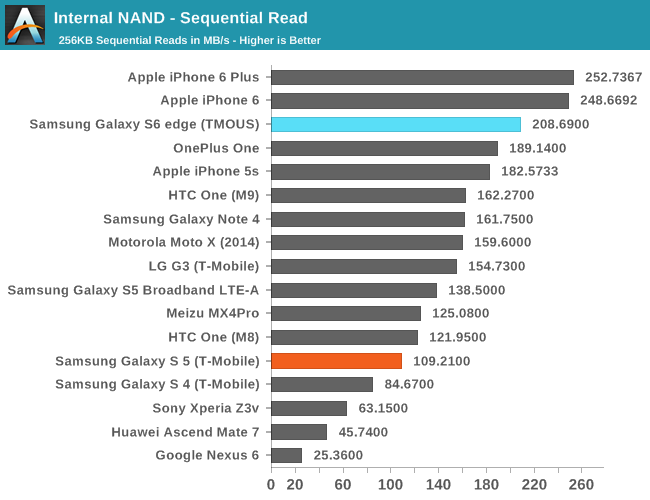
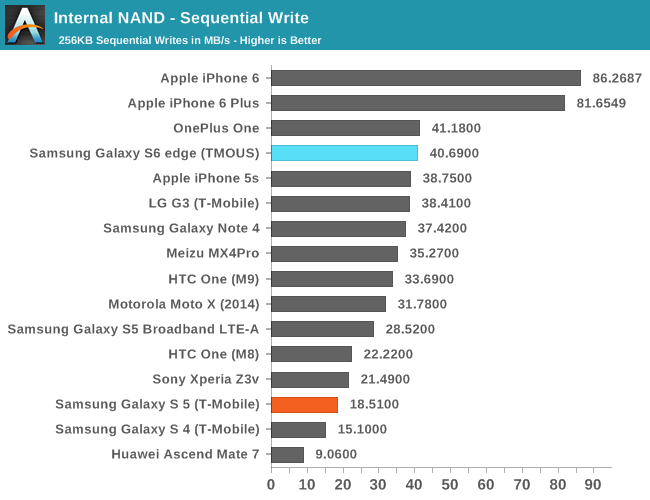
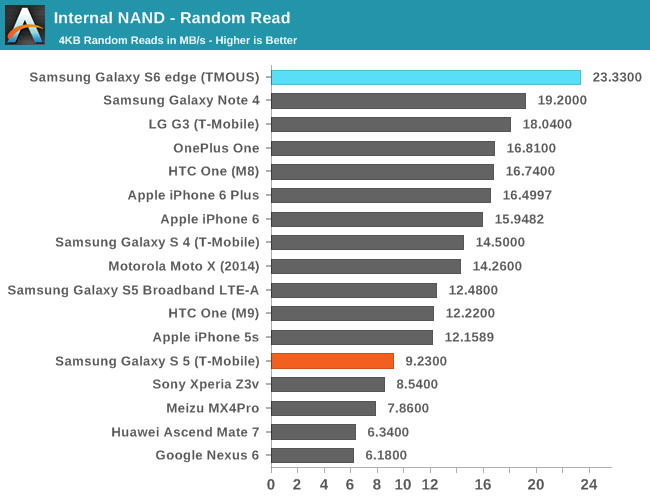
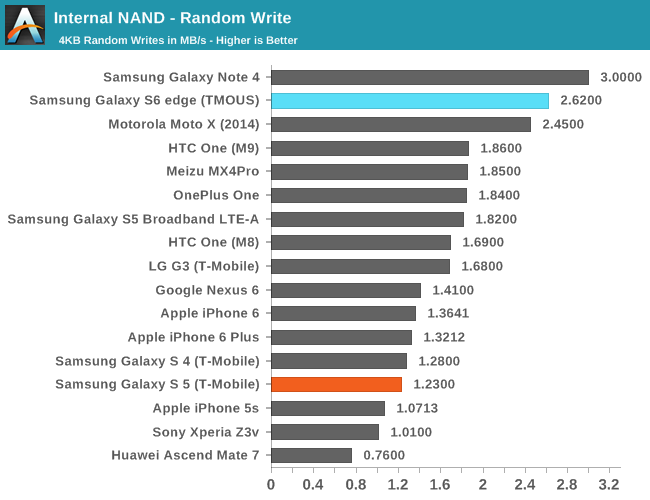
The Galaxy S6 performs rather impressively in our standard storage test, but not as fast as one might have hoped. This is due to the nature of the Androbench 3.6 test, which only tests a single IO thread, which won’t use the UFS storage of the Galaxy S6 to its full extent. In order to see the kind of difference that UFS really makes, I ran the same test again on Androbench 4.x, which does support multiple IO threads. However, as our iOS storage test and Androbench 3.6 don’t support more than a single IO thread we will continue to present both results for now.
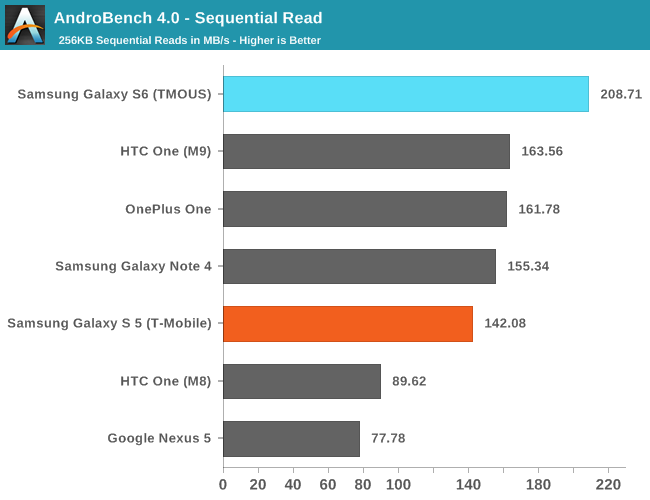
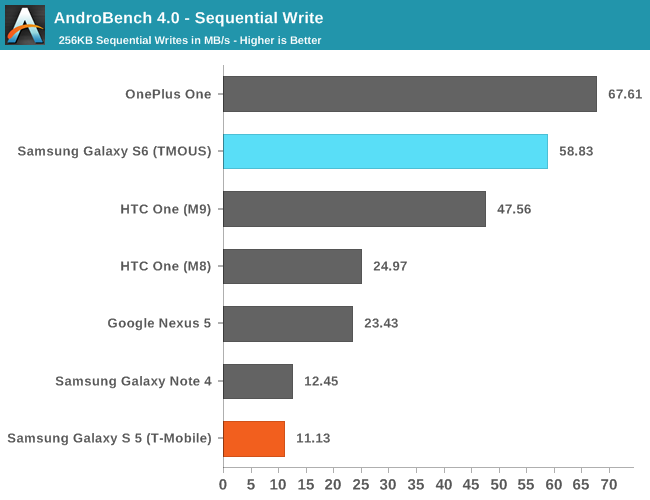
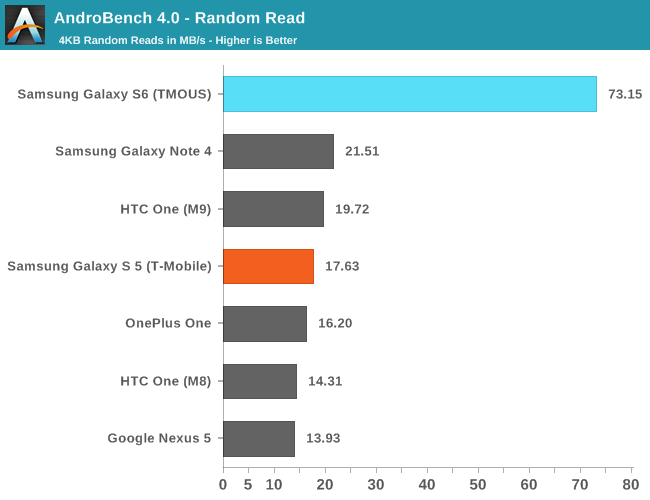
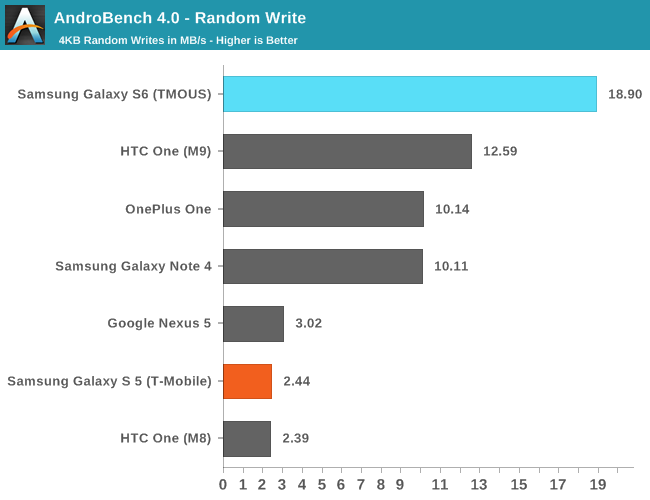
Overall, there are some immense benefits in storage performance here, especially in random IO performance. The Galaxy S6 has some of the fastest storage available in a phone today as far as I can tell given that this is basically a pure MLC solution, and shouldn’t have any real issue with storage performance holding back the rest of the phone over the course of 1-3 years as long as a reasonable amount of free space is kept to allow efficient storage management.


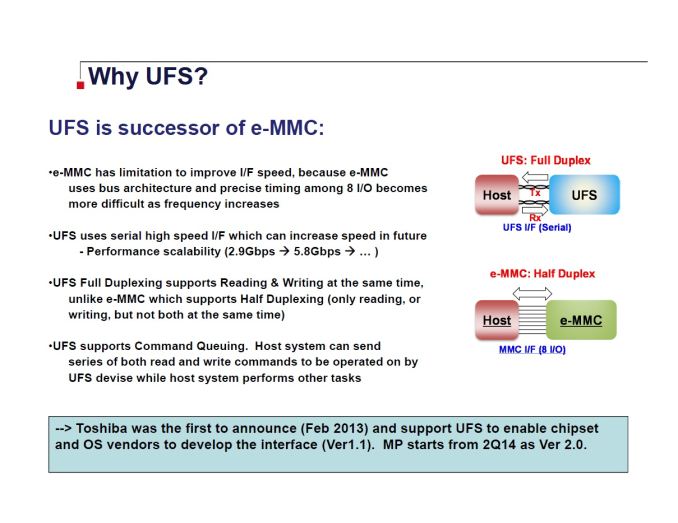








306 Comments
View All Comments
Richa - Friday, May 15, 2015 - link
Am from India - Bangalore. I bought Samsung S6 edge 64 GB on 12th April 2015 and got to know battery is discharging rapidly within first week of use. I spoke to customer support and sent it for service center. Service center person and his manager said phone does not have any problem and returned same defect phone without fixing. Samsung is least bothered about their customers and service center guys are too unprofessional. Please help me what can be done. Battery back up is less than 3-4 hours.Samsung has the worst customer service. First they sell you defective pieces which starts showing problem within a week of purchase and then they will ask you to visit the service center 3-4 times a month just because their technical team is not strong enuff to recognizee the problem. Samsung doesnt value customer time money ... it has just some stupid people sitting at the call center whose work is to fool you and simply waste your time but wont provide genuine service or product .Samsung is the other name of Customer Harassment. My personal Experience which I am going through these days.
techconc - Tuesday, May 19, 2015 - link
@Richa:You sound surprised. Why? Is there anything in your experience history with Samsung or even stories of their customer service that leads you to believe this is an anomaly? Your experience sounds pretty consistent with my experience with them.
An Droid - Monday, May 18, 2015 - link
Try reading the article again. Maybe you will then grasp the advantages of UFS over eMMC. If you still do not understand it, look at the graphs (the pictures).schilling - Wednesday, May 20, 2015 - link
Can someone explain why the video bit rate is so high? It is common for 1080P30 H.264 video to be in the 3-5Mbps range. I get the idea of increasing bit rates to improve quality, but 17Mbps seems ridiculous. I've seen many studies that clearly show that 1080P30 H.264 quality improves very slowly for bit rates above 5Mpbs. Netflix streams 1080P30 in the 1-2Mbps range; and yes their are artifacts, but this is 17-8x higher! The only logical explanation is that Samsung Exynos 7 is taking radical short-cuts in their H.264 CODEC. For example, using only I-Frames, or keeping a very small motion search area.Does anyone have insight to this? Has anyone viewed their stream with a CODEC analysis tool like StreamEye?
Why is Samsung's bit-rate so ridiculously high?
The Rogue Tomato - Saturday, May 23, 2015 - link
Removable battery and no microSD card isn't a big deal anymore. You can get a great quick-charge-capable $20 10,000 mah external battery now that you can use with your own phone, or your girlfriend/wife/boyfriend/husband's phone, too. Just today I wanted to be able to have an extra power source for my phone and my wife's phone. A $20 thingy would be ideal for that.And although I have one with my Note 4, I don't see the point of having a microSD slot anymore. I'd rather have the faster internal storage. It's not like I'm going to carry around 100 movies on my phone. If I really want movies, I can put them on a cheap thumb drive and use OTG.
bloosted - Tuesday, July 7, 2015 - link
You guys should revisit this and do an in-depth on the different camera sensors. Now that some time has passed, it's become very clear that the isocell sensors that some gs6 owners randomly end up with are greatly inferior to the sony sensors that you originally tested. Interestingly, it seems most (if not all) of the online reviews of the s6 and s6 edge were done on phones containing the fantastic sony sensor, which received near universal praise. Tom's hardware just did a review of the two sensors and found the isocell sensor greatly lacking.